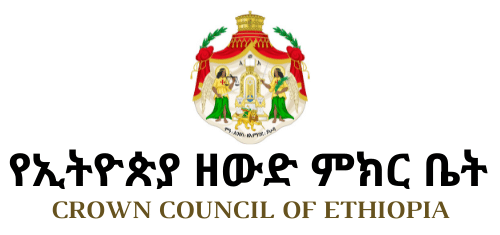The Imperial Orders and Decorations of Ethiopia
The civil war in Ethiopia, from 1974 to 1991, which resulted in the death of Emperor Haile Selassie and a diaspora of Ethiopians around the world, caused an interregnum which, until 1996, meant that few Imperial Orders or Decorations were issued. This was compounded by the dislocation, and subsequent re-establishment of the Crown in exile, and the deterioration of the health of Emperor Amha Selassie I. In order to begin preparing the Monarchy for a return to Ethiopia, Emperor Amha Selassie restructured the Crown Council and authorised it to take over many of the functions of the Crown.
Upon the death of the Emperor, in January 1997, and in accordance with the Constitution promulgated before the 1974 civil war, the Crown Council now has devolved upon it all the responsibility for Imperial Orders, Decorations, Appointments and Titles.
At present, the President of the Crown Council, HIH Prince Ermias Sahle-Selassie, and the Viceroy, HIH Prince Bekere Fikre-Selassie, are individually Grand Masters of most of the Imperial Chivalric Orders, except where noted.
In recent years, descendents of other branches of the Solomonic line — such as descendents of Lij Iyasu, who was removed from office in 1916 just before the coronation of Empress (Negeste-Negestate) Zauditu as Empress — have attempted to claim titles such as “Crown Prince of Ethiopia”, and to issue Imperial decorations.
Titles such as Crown Prince must be authorised by a serving Emperor and/or the Crown Council, and only serving Heads of the Ruling Family or — during an interregnum — the Crown Council have the authority to confer Imperial honours and titles, as confirmed by the Imperial Constitution, a fact confirmed by the last Imperial Afe-Negus and Minister of Justice, Afe-Negus Teshome Haile-Mariam to this author.1Conversations between the author and the Afe-Negus during 1997, and confirmed by the 1998 statement by Afe-Negus Teshome Haile-Mariam.
No other member of the Imperial Family at present has the right to issue Imperial Honours other than the Crown Council through its President, who is advised by his Honours Committee to which all proposals for recognition are submitted.
The Imperial Orders and Decorations are listed below in order of precedence with one notable exception. The Order of St. Anthony is considered separate. It is believed to be the oldest chivalric order in the world, and is a body of knights and companions, to which appointments are made only rarely and with distinct chivalric obligations.
As with all orders of chivalry and State or Royal decorations in countries which employ them, some orders fall into disuse or out of fashion, and new orders are from time-to-time created to reflect the distinct form of recognition which a sovereign or the Royal or Imperial house wishes to bestow. This is true of the Ethiopian orders. The Order of Solomon, for example, is rarely given; the same applies to the Order of Solomon’s Seal, and the Order of the Queen of Sheba. These orders are, however, and despite the rarity of their use, still valid and official.
Some of the Orders, Decorations and Medals carry the right of the recipient to use post-nominal initials signifying the honour. This is not an Ethiopian custom, but rather an accommodation permitted by the Crown Chancery for use in international situations to conform with international practice.


